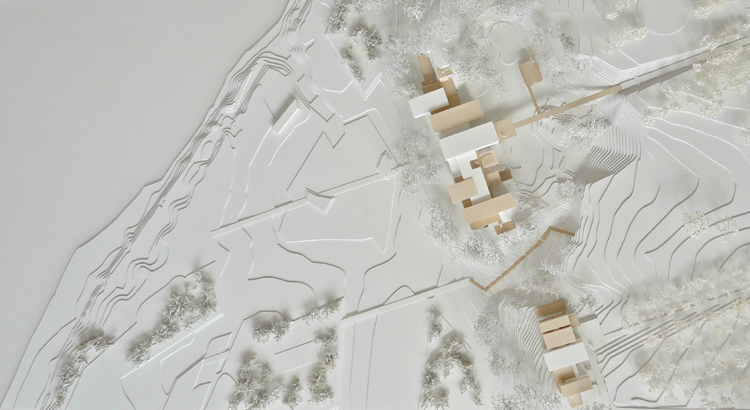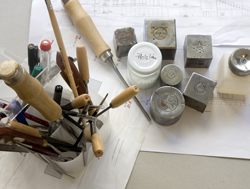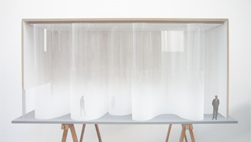bauraum Model

Country Residence Moscow Architect: AS. Architecture-Studio
“…Better than that the models are not accurately finished, refined, and highly decorated, but plain and simple, so that they demonstrate the ingenuity of him who conceived the idea, and not the skill of the one who fabricated the model….” Book 2, Leon Battista. De re aedificatoria. On the art of building in ten books. Cambridge, Mass.: MIT Press, 1988, p. 34
bauraum practices its trade in the spirit of Leon Battista Alberti. Whether it is a model for architecture, urbanism, landscapes, art, cinema, theatre, a design or engineering prototype, bauraum seeks to express the soul of the project.
bauraum Model offers a wide range of different model types.
A multifunctional tool

The model is a professional tool that takes on multiple uses and fulfils very different objectives. Whether it is an architectural or artistic project, the model enables those involved in the project to evaluate it in three dimensions, ascertain its effect and test the concept or its implementation as well as to stimulate a creative conversation. At each project stage, the model is a key tool for communication and mediation.
Typologies
The model is not only a simple representation in miniature of the architecture or the object it represents, it also speaks for the project and can even become a work of art in its own right. There are two main categories of models: those made during the process of project design and those representing a completed phase.
Examples of model types that we can provide during the design process:
The study model or working model is a research tool that enables its designer to test their initial idea, evaluate its pertinence, fine-tune or modify it. This type of model serves as a research tool into the form and details or as a way of testing site compatibility. It can be a volumetric or a sectional model.
The technical demonstration and test model is intended as a tool to check and verify calculations of complex structures. It helps to develop the project and is an important working tool for the architect, engineers and supervising offices. This can include aerodynamic, acoustic models or models for form finding as well as models which study the structure.

Susanna Fritscher, 2013, model for the exhibition
« promenade blanche / weisse reise » at the FRAC Franche-Comté, Besançon, France
The experimental model gives architects and artists the opportunity to study their project from different angles. A certain level of abstraction and stylisation reveals the connections between materials and form. The model can be photographed or used in montages to reflect many aspects of the design, for instance, the use of an endoscope can draw the viewer’s eye inside the model. The experimental model can also be instrumental in interior design projects and facilitate designs for theatre sets.
Examples of models we can provide during the advanced phase of a design process:
The competition model, is often white and neutral, enabling the jury to evaluate the architectural project in three dimensions, without any distractions.
The sculptural model is more than a tool, it is an artistic object in its own right.
It is often made with noble materials. Sometimes carved from the block, it becomes a precious object, a fetish. Moreover, the sculptural model is perfectly suited to explore architectural or urban utopias. Often abstract, rarely true to scale, it interprets a reality or displays an ideal.
The prototype model is the first sample – or one of the first – of a design object, true to scale. It enables the team to confirm their ideas about materials for a project and verify the object’s ergonomic quality.
The presentation or exhibition model is probably the model that is closest to a literal translation of a project. It not only describes the architectural project but also promotes it. When this model is displayed, it is made spectacular by illumination, carefully chosen materials and the degree of its precision and realism. This makes it not only a tool for communication but something that is also destined to seduce the clients and decision makers.
Techniques
Everything is significant in a model: the scale, the materials, the colours and the production method.
We select the materials that are the most apt to express the character of the project and we are able to suggest the most appropriate scale for the project dimensions and its details.

The production methods for our models use both analogue and digital technology, technologies that we deem to be essential and inseparable. In our studio, we combine the use of traditional tools with laser cutting and engraving.
We also have access to a wide range of technologies including 3D printouts, stereolithography, etching technology and laser sintering.
We counsel our clients on surface treatments and their effects and can give advice on materials, structures and colours, of which a wide range of samples are available for viewing.
Services
On request, bauraum Model will organise the insurance, packaging and delivery of the model.
bauraum will assist with the installation of the model and can offer a bespoke service to the client’s needs in the context of exhibitions, fairs etc.
bauraum projects are documented and photographed by a professional photographer on request.




